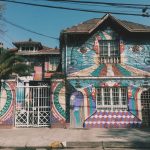If you happen to be in the Southern Cone during this Halloween season and are in search of a spooky experience, you are in luck. Throughout Chile, Argentina, and Uruguay, you can find Ghost Towns that are both viscerally haunting as well as rich in history.
Chaitén, Chile
In May 2008, the former capital of the Palena Province experienced the vigor of its nearby volcano when it unexpectedly erupted for the first time in 9,000 years. The town of Chaitén sits in the Lakes District region, covered in ash echoing the
eerily spectacle of those who have faced similar fates such as Pompeii and Plymouth. It became entirely flooded when the violent eruptions induced the Blanco River Banks to overflow causing the water to make its way through Chaitén. The matter of rebuilding the town has been one of controversy, but the final agreement was to rebuild the town in an area father north.
Humberstone and Santa Laura Saltpeter Works
Humberstone and Santa Laura serve as haunting memories of the once booming industry of Potassium nitrate in South America. Both former saltpeters are located nearly 50 miles east from the city of Iquique in the Atacama Desert. In the 1800s these spots – then part of Peru and Bolivia – were in demand by European and American customers who utilized the compound for gunpowder, explosives, and fertilizers. After Chile’s victory in the 1978 War of the Pacific between Chile, Peru, and Bolivia, Chile gained the territories that included the saltpeters. However, with the invention of synthetic nitrate in the 1960s, both of Humberstone and Santa Laura were abandoned. In 2005, UNESCO announced both ghost towns as a World Heritage Site.
Villa Epecuén
This site became increasingly popular in the sixties and seventies, with tourists journeying to the area to benefit from the healing properties of the mineral-salt waters. However, in November of 1985 a certain weather pattern that engendered unusual amounts of rain led to the rupture of the town’s dam allowing the waters of the lake to consume Villa Epecuén. Consequently, the once touristic spa town of Villa Epecuén became completely uninhabitable, as it remained underwater for 25 years. The town went from having over 20,000 tourists a year to a single habitant who still resides there today.
Chuquicamata
As the world’s largest open-pit copper mine and Chile’s largest producer of copper, the township of Chuquicamata was once home to over 20,000 residents who mainly worked in the mining industry. Unfortunately, due to increasingly dangerous amounts of pollution and dust from the mines, Codelco – a Chilean copper mining company – relocated all residents and their families to the nearby city of Calama due to the concern of health hazards. As a result, Chuquicamata became a completely intact ghost town with schools, homes and buildings but not a single person in sight (unless you count the reported sightings of ghosts and lights mysteriously being turned on).
Garzón
Pueblo Garzón used to be a buzzing village with an important train station until the mid 20th century when Uruguay decided to discontinue the station, sending thousands of residents scramming out of town in search of work elsewhere. The Village decreased in the amount of residents from the thousands to only a few hundred. This however changed when renowned Argentine chef Francis Mallmann opened a small hotel and restaurant with rustic charm drawing in visitors in search of a unique culinary escapade. While this village may not be entirely vacant, it still maintains the air of being a remote village lingering in the past filled with farm animals, dirt roads, and gauchos riding around the town.

